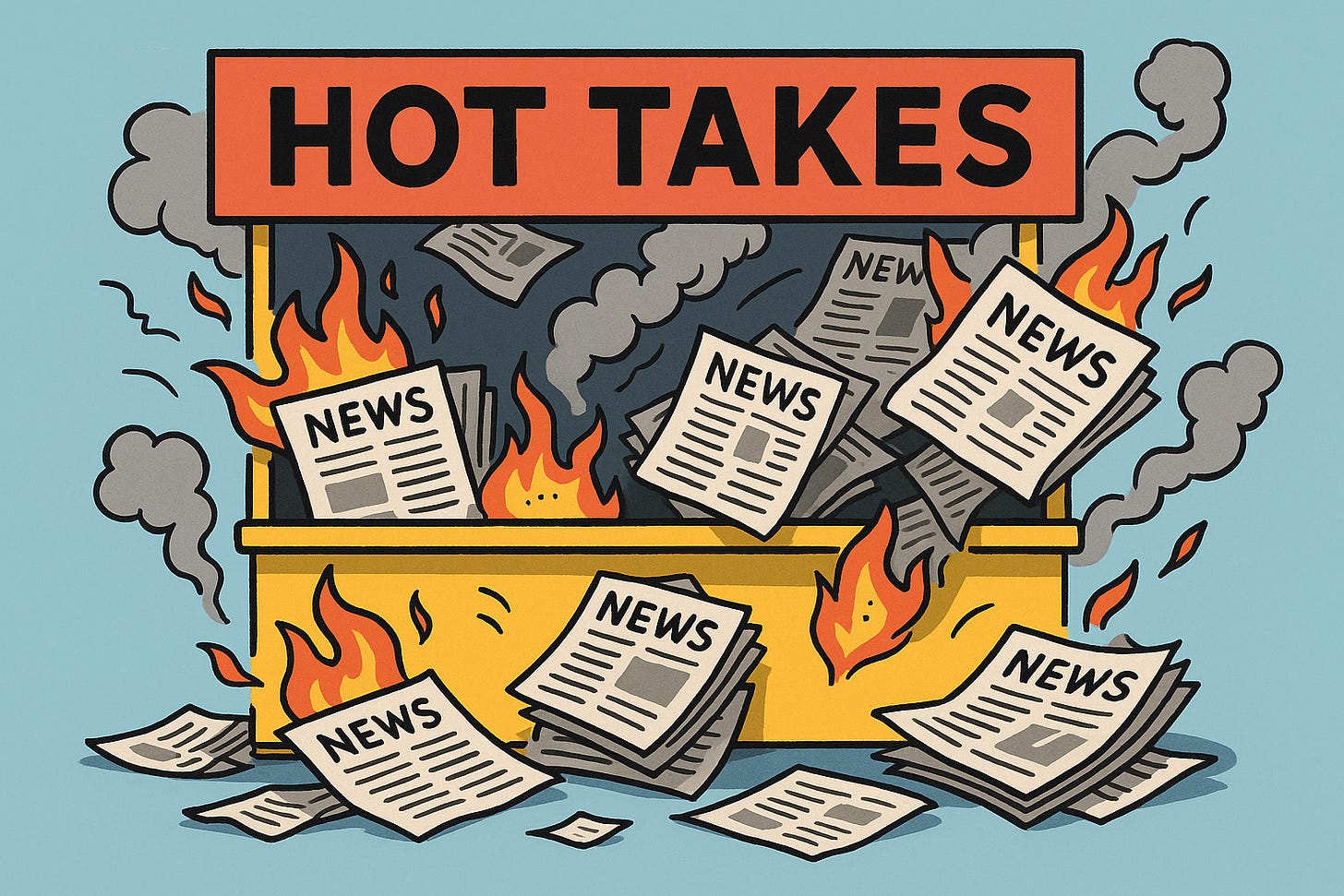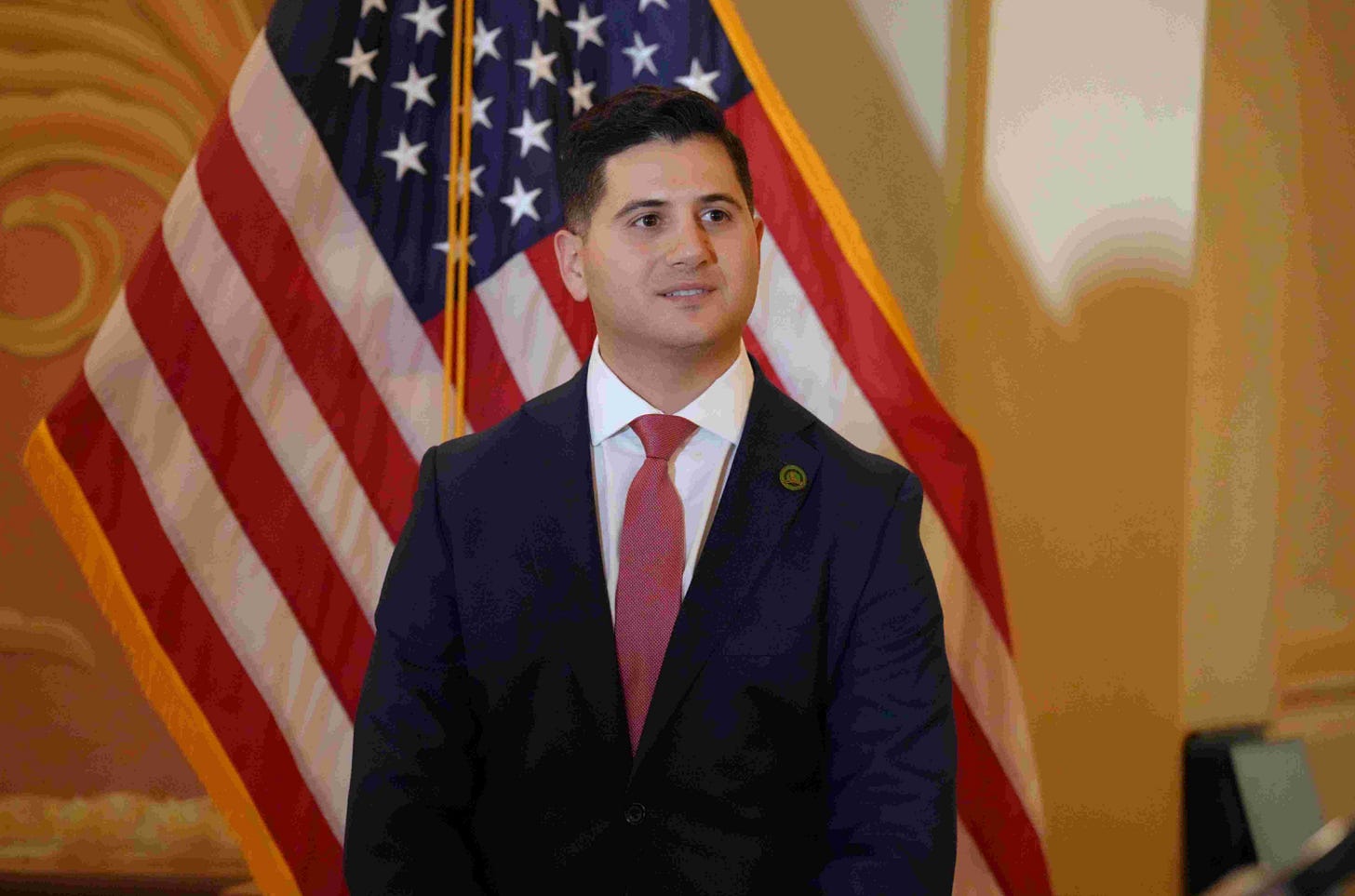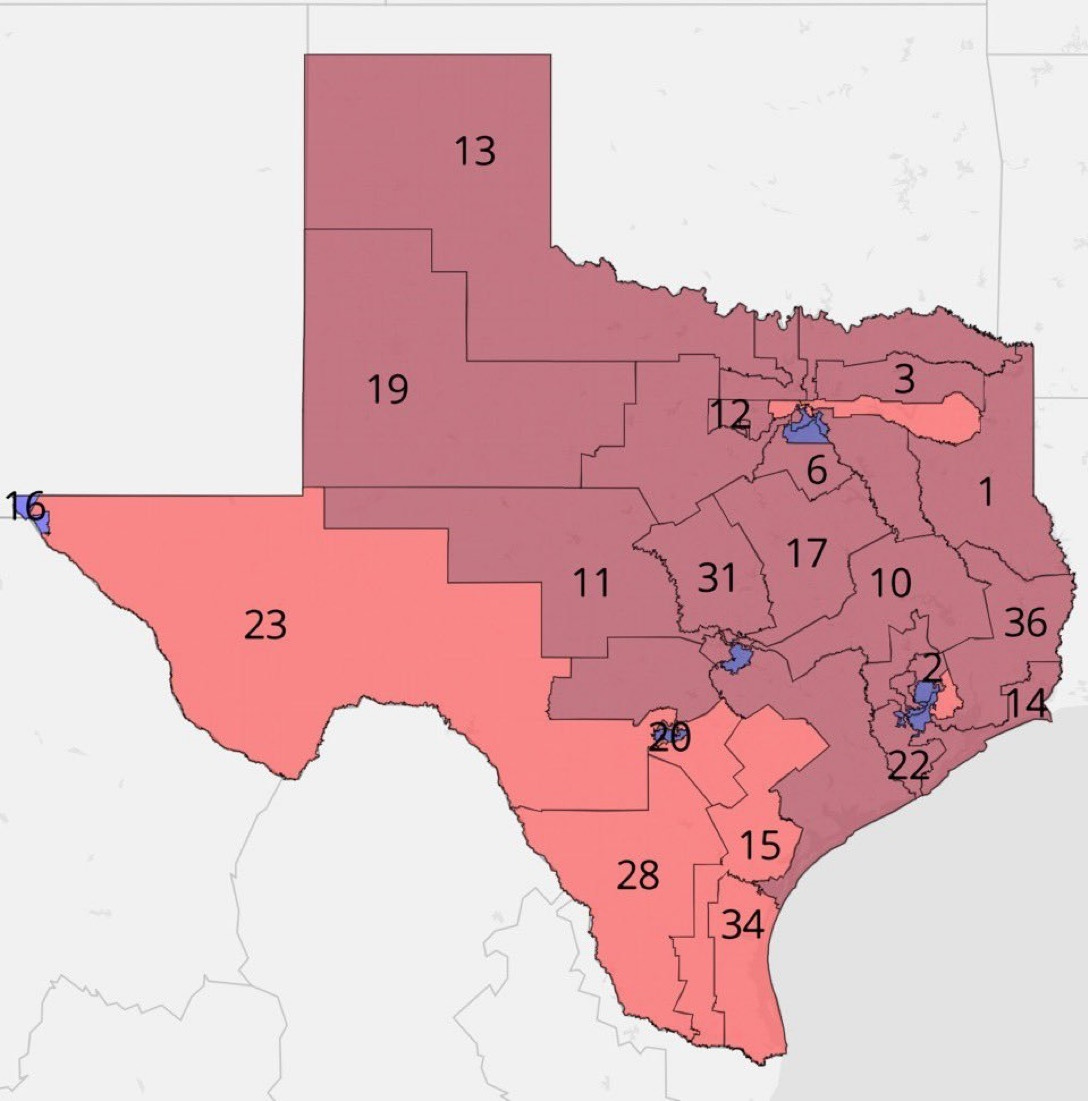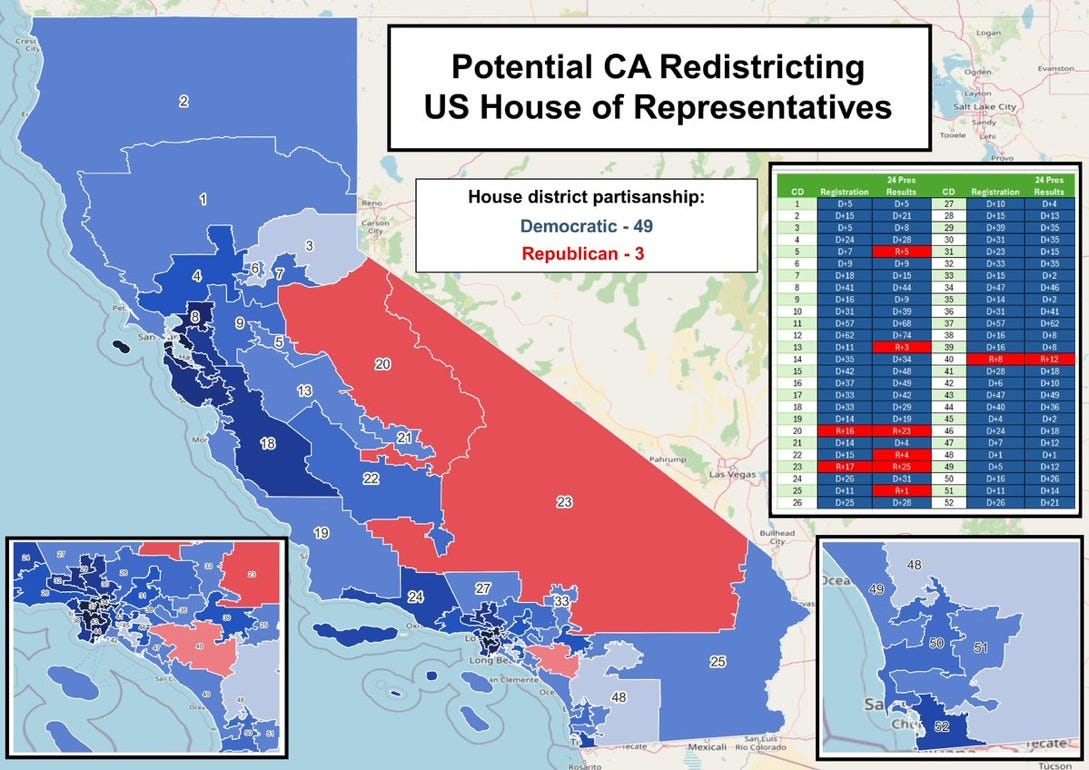Hot Takes: Harris NOT running for Gov, Essayli’s Extension, Which GOP House Members May Vanish, Can Dems Be Introspective? Kamchatka!
Below are a few items that I have been pondering today. So I invite you to ponder along with me!
⏱️ 4.5 Minute Read
So Kamala Harris has announced that she is not running for Governor.
There will be lots of stuff on that these next few days…
My Hot Takes…
In An End-Run Around A Slow U.S. Senate, Trump Extends Essayli’s Tenure as Acting U.S. Attorney
Yesterday, the Trump administration executed a calculated political maneuver that kept Bill Essayli firmly planted as the acting U.S. Attorney for the Central District of California. Just as his 120-day interim term expires, the administration found a way around the Senate confirmation roadblock that has plagued many of Trump’s picks.
Attorney General Pam Bondi appointed Essayli in April, and everyone knew what was coming. California’s Democratic Senators Alex Padilla and Adam Schiff would never let this former Riverside County assemblyman and Trump loyalist sail through to a permanent appointment. The writing was on the wall from day one.
But at exactly 5:01 p.m. yesterday, the administration pulled what amounts to a legal end-run around the Senate. By re-designating Essayli as “acting” U.S. Attorney under the Federal Vacancies Reform Act, they bought him another 210 days in one of the country's most important federal judicial districts. The move was shrewd, and it was necessary.
This is not happening in isolation. Trump has used identical tactics in New York, New Jersey, and Nevada, where his chosen prosecutors have remained in their positions despite Senate Democrats playing their usual obstruction games. The pattern is clear: when the Senate refuses to do its job, the administration finds another path forward.
Chief Judge Dolly Gee had the opportunity to intervene but chose not to act on Essayli’s appointment. That decision effectively opened the door for this extension, preventing a judicial panel from stepping in to fill what would have been a vacancy. Essayli himself seemed to know this was coming. During a recent appearance on Glenn Beck’s show, he dropped a hint suggesting his team had been preparing for this scenario. “We’ve got some tricks up our sleeves,” he said with the confidence of someone who knew the game plan.
Since taking office, Essayli has wasted no time making his mark. Within twenty-four hours of his swearing-in, he established the Homelessness Fraud and Corruption Task Force, targeting the staggering $2 billion in taxpayer funds that have seemingly vanished into California’s homelessness industrial complex. This was not just symbolic politics—it was a direct assault on the dysfunction that has allowed one of America’s wealthiest states to become a showcase for policy failure.
His approach to protests targeting immigration enforcement operations has been equally decisive. While critics point to mixed results in securing indictments, Essayli’s message has been unmistakable: federal law will be enforced, and those who interfere with lawful operations will face consequences. This is precisely the backbone that has been missing from federal law enforcement in California for far too long.
Attorney General Bondi has stood firmly behind her choice, describing Essayli as a “champion for law and order.” That endorsement carries weight, reflecting that Essayli represents something California has lacked: a federal prosecutor willing to challenge the progressive status quo that has turned parts of the state into lawless zones.
Essayli’s continued leadership in the Central District of California signals a fundamental shift in how federal law enforcement approaches the challenges that have been allowed to fester under years of progressive mismanagement. His focus on rooting out corruption and holding bad actors accountable aligns perfectly with Trump's broader agenda of restoring order to American cities.
If New House Lines Are Drawn For California, Which GOP Members Are In The Crosshairs?
The latter half of 2025 is shaping up to be the half-year of “Redistricting Wars.” Republicans and Democrats are looking to try to change House District lines to amplify their partisan advantage heading into next year’s mid-term elections, where most believe that the only real opportunity for Democrats to stymie the second half of a Trump Presidential term would be to take the House.
Governor Newsom has thrown down the idea that if Texas redraws maps, he will see that California does the same. You can read a lot online about Newsom’s task ahead and the challenges in getting this done (hint: it would require a statewide ballot measure). Texas has 38 congressional districts. Republicans hold 25 seats, and Democrats hold 13 seats (technically, there is a vacancy, but it is in a safe Dem seat). Here is a map of how pundits think a redraw would look there. Notice the Dems would shrink to a pretty small number of seats.
California currently has 43 Democrats and 9 Republicans. But a potential map would reduce Republicans to only three safe seats.
I spoke with a California redistricting expert yesterday. For those curious, with this map, Rep. Darrell Issa would be the only Republican sitting pretty, with a re-election to a very red district secure. For the other two Republican seats that would be very safe, two incumbents would have to duke it out. Vince Fong and Jay Obernolte are in one, and Tom McClintock and Kevin Kiley are in another. Brutal. Oh yes, you would say “bye bye” to not only the loser of each of those two showdowns, but also Doug LaMalfa, David Valadeo, Young Kim, and Ken Calvert.
As we would say, this story is definitely still developing…
John Halpin Warns Democrats: Anti-Trump Stance Alone Won’t Revive Party
John Halpin, a centrist political analyst writing for The Liberal Patriot, has delivered a brutal reality check for his party. His message is blunt: Democrats cannot simply coast on anti-Trump sentiment if they hope to climb out of their current political crater.
The numbers Halpin cites are devastating. Democratic favorability has reached historic lows, and the party’s brand has become so toxic that its criticism of Trump lacks any credibility with voters who matter. This is not just about losing elections—this represents a complete collapse of public trust in what the Democratic Party claims to represent.
Halpin’s analysis cuts to the heart of the Democratic dilemma. The party has spent years talking past working-class Americans, focusing instead on cultural issues that resonate in faculty lounges and corporate boardrooms but fall flat in communities where people worry about paying rent and keeping their jobs. The disconnect has become so severe that even traditional Democratic constituencies are tuning out.
The enthusiasm gap among Democratic voters, particularly young men, tells the story of a party that has lost its way. How can you expect to persuade anyone else when your base shows little excitement for your message? Halpin points to this collapse in energy as evidence that Democrats have fundamentally misread what Americans want from their government.
Perhaps most damaging is Halpin’s observation about the party’s inability to articulate a coherent economic vision. While Republicans have successfully connected with voters’ financial anxieties, Democrats have offered little beyond recycled talking points about inequality and vague promises about job training programs that nobody believes will help.
The reference to “normie voters” feeling abandoned by coastal elites strikes at something more profound than political strategy. It reflects a cultural chasm that has opened between Democratic leadership and the ordinary Americans they claim to represent. When party leaders seem more concerned with pronouns than paychecks, they should not be surprised when voters look elsewhere for solutions.
Social media reactions that Halpin references reveal another uncomfortable truth: even Democratic activists struggle to define what their party stands for beyond opposition to Trump. A political movement built entirely on resistance cannot sustain itself once the target of that resistance is no longer the primary focus of public attention.
Halpin’s call for a “bold, inclusive platform” sounds reasonable enough, but it ignores his party's fundamental problem. Democrats have spent so much time catering to their most progressive elements that any move toward the center risks alienating the activists who provide the energy and funding that keep the party machinery running.
The challenge for Democrats goes beyond crafting better messaging or finding more appealing candidates. They face a credibility crisis from years of making promises they could not keep while prioritizing issues that matter more to their donor class than their voters.
An Earthquake Off Of the Coast Of Kamchatka, Russia? Risk Players Know Where That Is….
When news broke yesterday of the massive 8.8 earthquake off of the Russian coast near “Kamchatka” I’m sure most people were like, “Where’s that?” But not Risk players. It’s a territory on the map! The one you pile military units on to block an invasion of North America!
Have too much time on your hands? Playing Risk on your device is a great way to mindless lose hours! But you will understand the strategic importance of Kamchatka. LOL.







